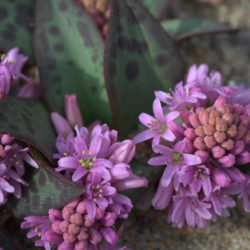Scientific Name
Ledebouria ovatifolia (Baker) Jessop
Common Name(s)
Flat-leaved African Hyacinth
Synonym(s)
Ledebouria ovatifolia subsp. ovatifolia, Scilla lanceifolia var. ovatifolia, Scilla ovatifolia
Scientific Classification
Family: Asparagaceae
Subfamily: Scilloideae
Tribe: Hyacintheae
Subtribe: Massoniinae
Genus: Ledebouria
Description
Ledebouria ovatifolia is a bulbous plant with green leaves that may be unspotted or usually attractively marked with dark green to purple spots or blotches. Although it is not, strictly speaking, a succulent, it is favored by succulent growers. The leaves vary highly from one population to another and even across the same population. They are ovate, with a broad base, usually firmly appressed to the soil, and can grow up to 10 inches (25 cm) long. The plant is deciduous, with new leaves growing annually in spring.
The plant produces dense clusters of numerous small, pink to purplish-green flowers on flexuous stalks in spring and summer.
Origin
Ledebouria ovatifolia is native to South Africa (Eastern Cape, Free State, KwaZulu-Natal, Mpumalanga, Limpopo,and Gauteng), Lesotho and Eswatini. It grows in grassland and rocky hillsides.

Hardiness
USDA hardiness zone 10a to 11b: from 30 °F (−1.1 °C) to 50 °F (+10 °C).
How to Grow and Care
Silver Squill is often cultivated as a houseplant and grows with minimal care. However, it requires bright light with 3 to 4 hours a day of direct sunlight.
During the active growth period, interior temperatures are fine for Silver Squill's grown as houseplants. Outdoor plants can withstand winter temperatures below 30°F (-1°C). Try growing Silver Squill outdoors during spring and summer when ambient temperatures are at least 60°F (15°C). In cold regions, move the plant back indoors.
Use a soil-based potting mixture and plant Silver Squill bulbs in pans or half-pots. Pot up the bulbs in the spring, but no more than three in a single 4 to 6 inches (10 to 15 cm) pot. Space the bulbs evenly over the surface and bury only the bottom half of each bulb in the potting mixture. During the first 4 or 6 weeks, do not feed the plants and water sparingly, allowing the top half of the potting mix to dry out between waterings. Treat the plants as usual when the new roots should be well established. Break up overcrowded clumps every 2 or 3 years.
See more at How to Grow and Care for a Silver Squill.
Links
- Back to genus Ledebouria
- Succupedia: Browse succulents by Scientific Name, Common Name, Genus, Family, USDA Hardiness Zone, Origin, or cacti by Genus
Photo Gallery
Click on a photo to see a larger version.


